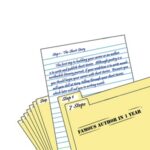When I say to writing students, “Your work is really strong. You should try sending it out to literary magazines,” they often respond with a terrified “What? Me?” look. How do you get past the fear and get your work out there? It helps to arm yourself with some basic information about the submissions process.
Approaching literary magazines is, in my opinion, less intimidating and more straightforward than approaching large-circulation consumer magazines. There’s usually no need to query before submitting your work; and you don’t have to worry about including published clips. You simply send your manuscript, usually with a brief cover letter and SASE (self-addressed stamped envelope). I’m not saying it’s a breeze. Getting published in literary magazines takes a lot of work, especially in the beginning. But if you’re willing to put in the effort, here’s what you need to know:
Basics:
—Get Writer’s Market if you don’t have it already–and no, it’s not necessary to buy a new one every year. The “For beginning writers” section has nearly everything you need to know about submissions, and it doesn’t change much from year to year. They do focus on large-circulation magazines rather than literary magazines, so much of the info won’t be relevant for you. However, the sections on rights and on formatting manuscripts are essential for anyone submitting to any type of magazine, literary or otherwise.
—Always check submission guidelines online before you send a manuscript: word length, reading period, etc. More and more literary magazines are accepting electronic submissions–a great development if you don’t want to spend a fortune on postage, paper, printing ink, and envelopes!–but the majority still accept snail-mail submissions only. Books and other listings for magazines are just starting points: the info may be old by the time you read it, or it may have been incorrect to begin with. Use those listings to get Web addresses and take it from there.
—Always read pieces from recent issues whenever possible. If you can’t find a particular magazine in bookstores, many will post selected pieces on their websites. Look for pieces which are similar to yours in terms of style, tone, length, and subject matter.
–Be careful about online literary magazines–many are well-regarded, while others might not have been around long enough to gain a reputation. Have the contributors won any awards? When was the magazine founded? (If it’s been around longer than a year or two, that’s a good sign. It probably won’t fold next week.) Is the website stylish and appealing? Do the editors have strong writing/editing credentials? You can find reviews of literary and online magazines at NewPages.com (see below).
–Personally, I don’t bother with magazines that don’t accept simultaneous submissions (pieces which are submitted to more than one magazine at a time). A magazine might sit on a manuscript for as long as six months, then end up rejecting it. I tend to submit a piece to 5-10 magazines at a time. If I end up with 5-10 rejection slips, I’ll take a look at the manuscript and decide whether to revise it or retire it. Some editors will take a moment to scribble a few words of advice on the slip if they think the piece has potential. If you’re fortunate enough to get such advice, consider it carefully! Incorporating an editor’s suggestion can make the difference between a piece that’s almost there and one that’s ready to be published.
Cover letters:
—Always address your cover letter to a specific editor whenever possible. The submission guidelines posted on the website might say, “Send to: Fiction or Nonfiction Editor,” without giving you a name. Go a step further-click on “staff” or “masthead” to find out who the editor is for your genre. If there isn’t one, address your letter-and your envelope-to the editor; again, get the specific name. This won’t ensure that your story will actually be read by that editor, but it shows that you’re willing to dig a little to find out more about the magazine; it makes you look professional. You may or may not need a cover letter for an electronic submission; if they don’t specify, send one just in case.
The cover letter follows a standard business letter format; refer to Writer’s Market to get an idea. They mostly give examples of query or cover letters for magazine articles and books-again, the content is not relevant for you, but the format is. For literary magazines, it’s best to be brief, professional, and to the point. Let the work speak for itself.
—Start with: “I am submitting the enclosed memoir/personal essay/short story, “[title],” for publication in BlahBlah Review.” You could then mention a piece from that magazine and say that you feel your piece’s style is similar. This shows you’ve actually read the magazine and thought about whether your work would fit in. Not essential, but it can’t hurt, and it just might help.
—New paragraph: This is where you can include a brief “bio.” Don’t mention that you’ve never been published (they’ll assume that anyway if you don’t list publication credits). Tell them about any writing workshops you’ve taken; this shows that you’re serious about writing as a craft. Mention your profession and academic degree, whether or not your work or area of study has anything to do with writing.
—Last paragraph: Be clear about the fact that this is a simultaneous submission, and assure them that you’ll notify them immediately if the story is accepted elsewhere. Mention that you’re enclosing an SASE for the return of the manuscript or for reply only, whichever you decide. End with a friendly closing: “Thank you for your consideration; I’ll look forward to hearing from you.”
—Double- or triple-check the editor’s name and the magazine’s address, both for the letter and the envelopes. Proofread and spell-check the hell out of the letter, and your manuscript for that matter. Other than proofreading, don’t fret too much over the letter; what really matters is the piece. Once you have it in place, you can use the same basic letter for all of your submissions.
Resources:
—Writer’s Market: Look under “Literary and Little.” Yes, these are mostly the big names; but some are newer and more open to unpublished writers. Remember that what they list is only a tiny sampling of the hundreds of print and online literary publications out there. Literary Magazines and Small Presses is probably a better place to start in terms of listings. There are many other books like these two on the shelves…browse away!
–NewPages.com: Alphabetical listing of literary magazines, print and online. Reviews, basic contact info.
—Poets and Writers magazine: Lists ads for publications under classified section: these are mags which are actively looking for submissions. Quality varies widely (and wildly). The articles are also very useful: book publishing, finding agents, interviews with writers, etc. I highly recommend subscribing. And be sure to visit the magazine’s website for links to hundreds of literary magazines, info on grants and conferences, and much more.
—Webdelsol.com: Very busy, flashy website-best to go straight to the “Literary Pubs” link, where you’ll find a selection of the new-and-trendy and the old-and-trusty. This site gets a lot of traffic, so being published by a magazine that’s listed here means good exposure.








